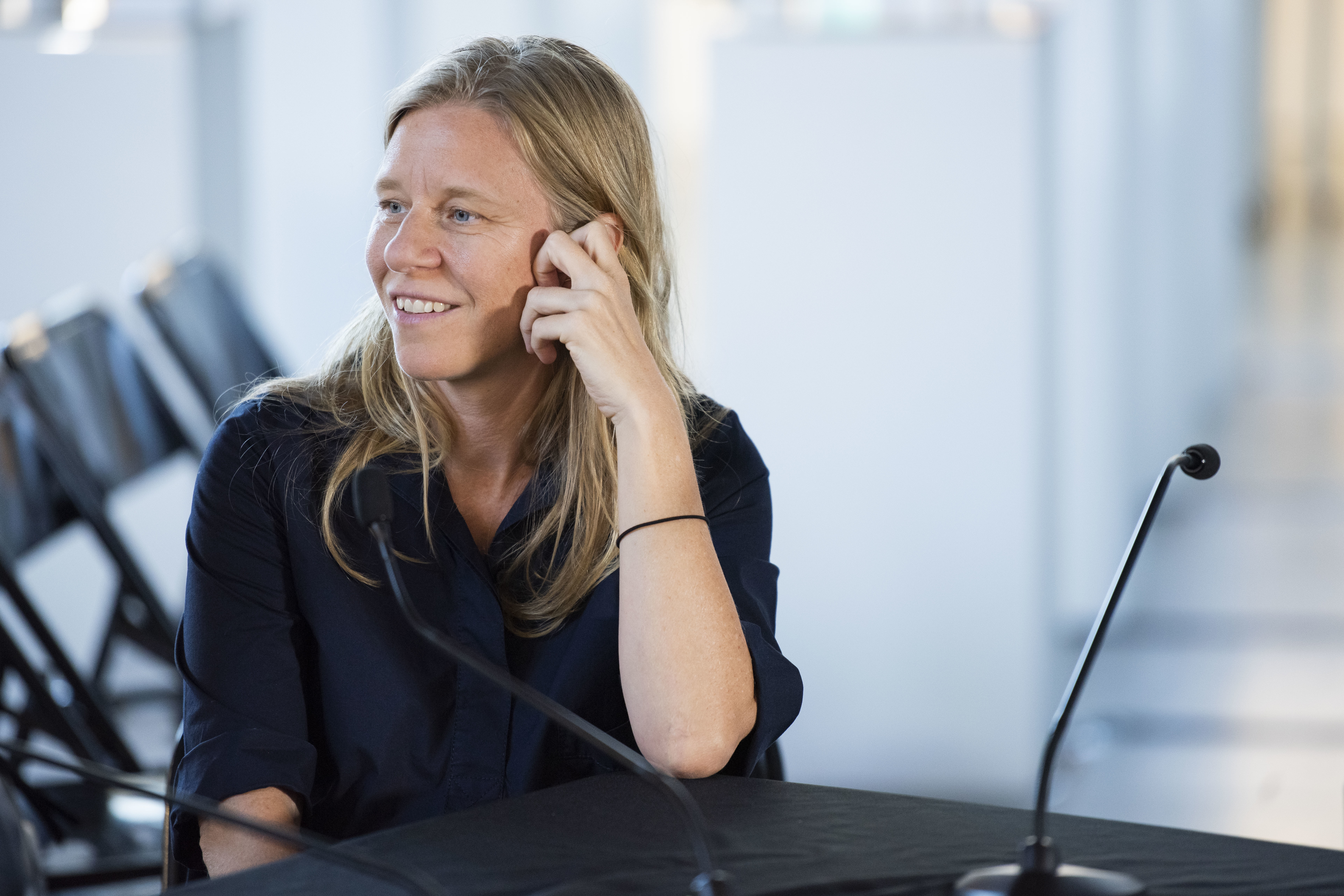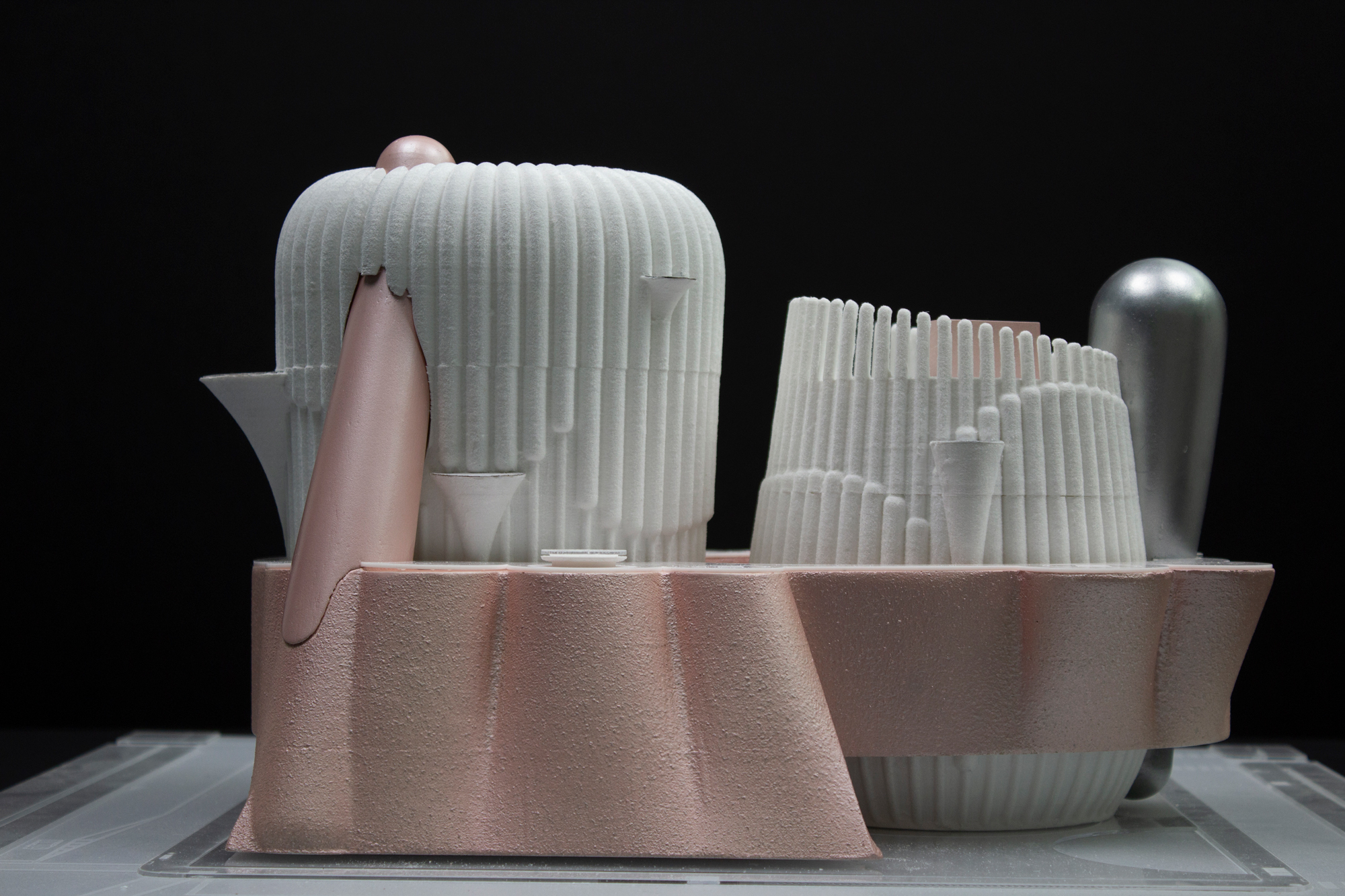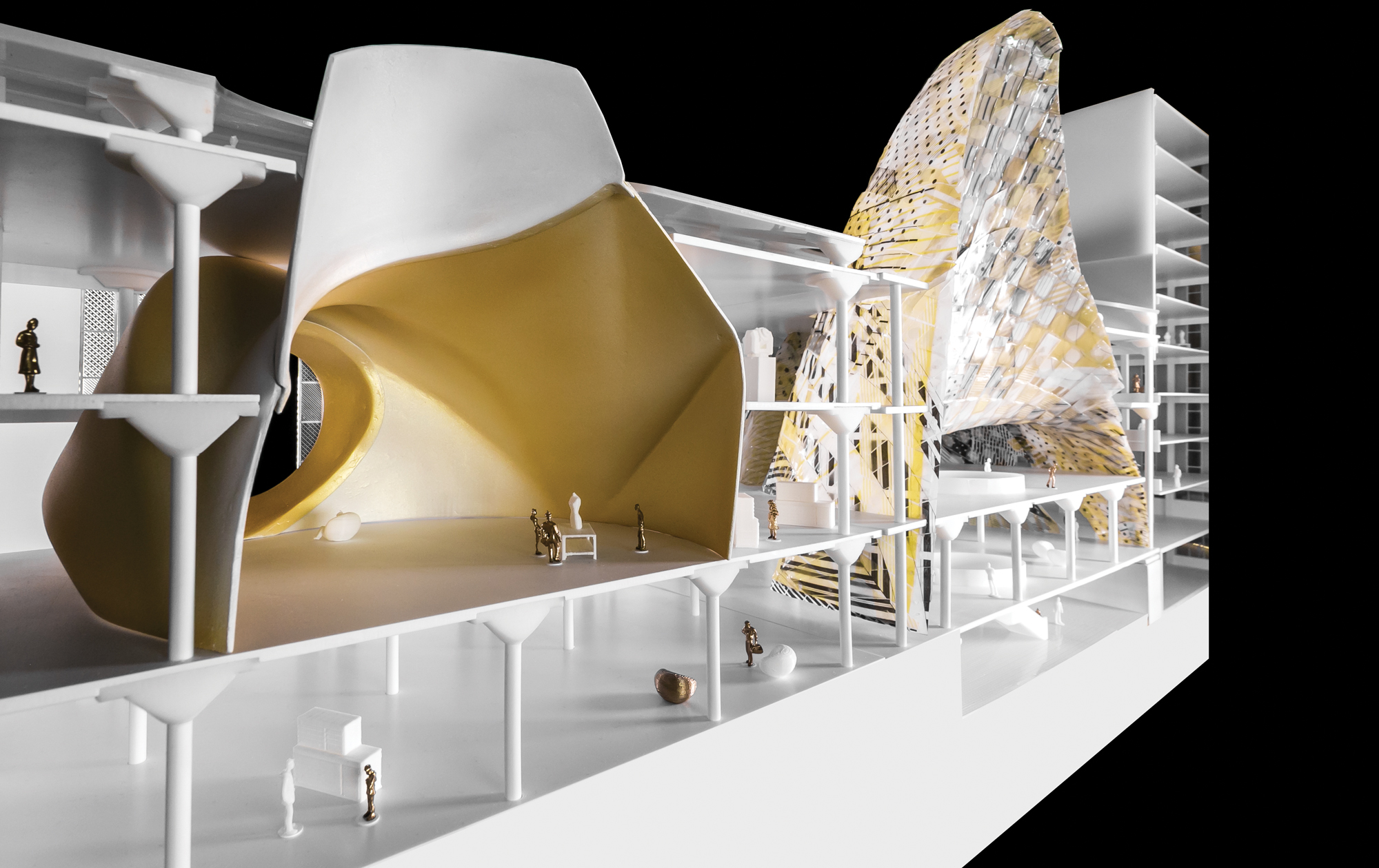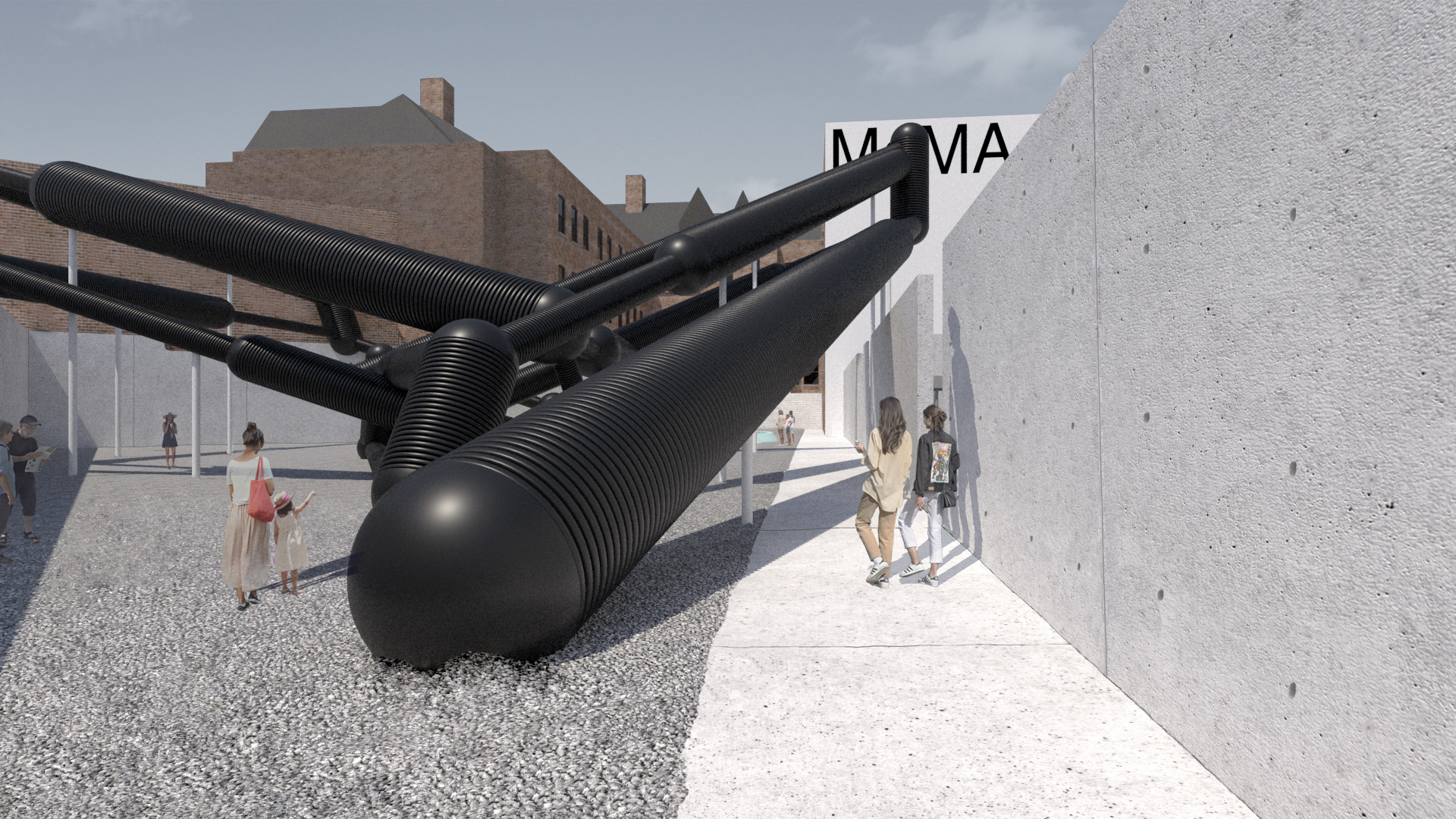Kristy Balliet on Volume, Practice, and Agitating the Discipline
Kristy Balliet is design faculty at SCI-Arc and co-founder of BairBalliet, a joint design practice with Kelly Bair. BairBalliet’s work has been exhibited in the US Pavilion at the 2016 Venice Architecture Biennale, Venice, Italy; the Museum of Modern Art, New York, USA; the Architecture and Design Museum, Los Angeles, USA; and the Museum of Contemporary Art Detroit, Detroit, USA. In 2018, BairBalliet was named a finalist for the MoMA PS1 Young Architects Program.

Prior to joining SCI-Arc, Balliet was an associate professor at the Knowlton School of Architecture at Ohio State University and an assistant professor in Studio Greg Lynn at the University of Applied Arts, Vienna. She holds a Bachelor of Architecture from Philadelphia University and a master’s degree from the UCLA Department of Architecture and Urban Design. Balliet has published articles on topics related to excessive volume and architectural ploys, and has co-edited several books, including: Massive Attack: Selected Friends and Enemies; Visual Catalog: Greg Lynn’s Studio; and in 2018 with her co-founders of the Possible Mediums project, Possible Mediums with Actar. Balliet’s research focuses on the volumetric qualities that are innate to architecture and seeks to expand them.
Her work incorporates both physical and perceptual volume through thoughtful relations of thickness, depth, and spatial sequencing. Balliet’s work addresses the desire for multiple subjectivities and develops tactics for recouping volume as a fundamental pursuit of architecture.
SCI-Arc: Hi Kristy, thanks for speaking with us today. First of all, how did your interest in architecture and design develop?
Kristy Balliet: It started very early. My middle school art program sampled different types of drawing, which included exercises in technical drawing. I became obsessed with that.
The drafted drawing requires attention and precision. I was immediately attracted to looking at something in detail, observing it, recording it, measuring it, and then turning that into a visual representation of a physical object. And I was good at it. I think when you are young and you find something that you're good at, you start to enjoy it. At that time, I did not make the connection to architecture. Architecture as a profession was not in my immediate view; I didn’t know any architects. I did, however, start to seek out more opportunities to pursue drawing.
When did you first make the connection between technical drawing and architecture?
I grew up in rural Pennsylvania and my high school had a very large vocational program, which included drafting courses. I was directed towards a sequence of vocational courses in electrical, civil, and mechanical drafting. If you completed all the courses, in your senior year you could elect to take architectural drafting.
I remember seeing that in the list of options, and I knew enough by that point to understand, “Oh, architecture is related to buildings…” I could relate to it. I wanted to be an architect long before I understood what that meant. I think the training in drawing helped me to see objects in the world differently—I was more attuned to their detail and nuance.

Do you think that engaging that part of architecture early on gave you more room to explore the conceptual side of design once you finally began your undergraduate studies in architecture?
Yes, I think so. Because drawing was important to me, I practiced it a lot. We often refer to the professional aspects of architecture as ‘architectural practice,’ but even the conceptual aspects—the drawing types, the model making—require a lot of practice as well. The vocational buildup in high school prepared me well for the decision to apply for undergraduate programs in architecture.
However, by the time I was in that first-year studio I was blown back on my heels, let's say, by the conceptual and discursive elements of the discipline that a freshman encounters. My understanding of architecture had to expand fast! On the other side, I was less intimidated by the attention and time that was required, and this gave me more confidence to take risks. I knew I could draw it and build it, so I challenged myself early to be uncomfortable.
Can you talk about the early stages of your architecture practice?
Immediately following graduation—literally hours after—I started to work for Erdy McHenry Architecture, a small office in Philadelphia. I was lucky; they brought me on as an intern, to work on a competition for a month. We won the competition and they hired me as their first employee. When I left seven years later, the office had grown to thirteen people. In those foundational years I was involved in every aspect of the office. In a small office you do everything.
I worked on projects at a range of scales including a 7-plex movie theater, a 1200 seat church, and several multiple-unit residential projects. It was a great start. In addition to learning how to practice and start an office, I learned how to punch above my weight. This is the type of thing you don't realize you're learning at the time. The partners were a duo that took a lot of risks. They had a small team of pretty green folks like myself but pursued projects at the edge of our capacity. They got the project first and then built the team to accomplish it.
How has the development of your career progressed based on your previous experience and background as a practitioner?
Today, my career is a balancing act between practicing and teaching. I try to leverage my experience in one area to expand the other. In many ways, I came into academia through the side door. It feels good now; like a solid fit, but it's not something I was pursuing initially. In many ways I still see myself as a practitioner, someone who wants to pursue architecture primarily as a building project.
In graduate school at UCLA I was immersed in a discourse around new technology and culture—this was in the mid 2000s. I found myself like many others in a unique scenario where I didn't have a lot of teaching experience, but I had early exposure to software that was impacting the discipline.
Following graduation, I returned to Philadelphia and continued to practice. During that time, I started teaching an evening design studio at Philadelphia University and a visual studies course at the University of Pennsylvania. They were both adjunct positions in addition to my full-time position in an office. This overlap allowed me to gain teaching experience and rub elbows with broader conversations. It was a very dense time, during which I started to expand my understanding of what architecture is and how I could participate and contribute. I enjoyed teaching and quickly realized that it was another form of learning.
In 2006, Greg Lynn offered me a teaching position in his studio at the University of Applied Arts in Vienna, Austria. I was given the opportunity in large part because of my combination of practice and teaching experience. He was looking for someone who had a practice background but was also fluent in the contemporary discourse. He took a risk on me. I had less teaching experience than most of his teaching assistants, but I had a bit more perspective from the building point of view. We initially agreed only to one semester, but in order to make this move I had to quit my three jobs—it was a big leap. Looking back, that decision changed the course of my career.

How long were you ultimately in Vienna, and what were you able to do during that time?
I ended up staying in Vienna for five years. In addition to teaching, the institute had many opportunities for other forms of engagement. Wolf Prix was the head of the school at the time and he was incredibly supportive of us engaging in the institute at large. Along with my colleagues Brennan Buck and Alexandra Graupner, we started a gallery and lecture series, called the Sliver lectures—the idea for which was to take a deep but acute look into architecture.
The series provided myriad ways to make connections and foster conversations at the school and beyond, and to expand the visual language of the studio. We also traveled extensively as a studio for one week each semester; to Moscow, Croatia, Italy, France, England, and Germany. My role was to guide, curate, and focus the questions of observation. I still lean on that expansive range of experiences.
So you developed a community that way in terms of the academic discourse?
Exactly. And I also coedited two books during that time that reflect the unique community there. The first was the Visual Catalog. It was focused on the studio Greg Lynn, highlighting the themes of teaching and design innovation. The institute is unique in terms of pedagogy because it evolved out of the apprentice-style environment common to applied arts. Students do not apply to the school; they apply to the professor.
At the time, they completed their entire five-year bachelor’s degree within one studio—first- through fifth-year students were taught side by side. This impacted my view of education and the role of a design community. The second book is titled Massive Attack, Selected Friends and Enemies and chronicles the tribute lecture series that we curated on the occasion of Wolf Prix’s retirement from the institute.
What was your experience like after leaving Vienna in terms of your career?
After teaching for five years in Vienna I was interested in the parallels or overlaps within US academia. I accepted a tenure track position at the Knowlton School of Architecture at Ohio State University in 2011 and taught there for five years. The tenure process was a new challenge.
In addition to teaching and servicing the school, the biggest requirement is to figure out how you're going to move the discursive needle. It was a great experience. I had great mentors throughout that process and their biggest advice early on was, "You may have a lot of ideas, but for these five years; focus on one." This was an important piece of advice.
What were some of your conclusions during this formative time, working on such meaningful project(s)?
One conclusion I drew was that I saw volume as a project—at the time I called it excessive volume. The project took a renewed interest in volume as territory to be designed and authored. I was taught about architecture, mostly through mass and objects, the idea of looking at something. And I was curious: A) why? and B) what if architecture started with volume; with the interior. How could volume negotiate with the massing—be an active participant in the ways that we refer to a building.
It started as an observation, and then moved more towards an obsession of: What is volume? What's its role as a medium? What's its role in how we develop qualities in architecture? What's its role related to the exterior? Can volume and mass become like two well-matched wrestlers in the ring, where they're flip-flopping roles and vying for attention?
Volume has many synonyms, including space, interior, and container. But a lot of the work I was investigating was related to how these terms are different. I concluded or made some assertions that one of the major differences is that volume needs to be authored, whereas space can be thought of as infinite or left over. I was interested to see if volume could have a set of problems equivalent to massing issues related to profile; the way it hits the ground and the way it hits the sky. Could we expand or shift the set of problems that architects work on and address them to the surfaces that define volume—floors, ceiling, walls, niches, etc.?

How does that set of assumptions translate into your later and current projects?
The Possible Mediums project developed in part out of these questions along with a larger interrogation of mediums of architecture. Four architecture colleagues—Adam Fure, Kelly Bair [Balliet’s now-partner], Kyle Miller, and myself—across four institutions in the Midwest hosted a collective conference and subsequent exhibitions to interrogate the expanding mediums of architecture.
We were a group of architects in the Midwest that had been hired around the same time and asked to advance similar issues and techniques within our respective institutions. We began to realize how pedagogy and technology were rapidly evolving; it felt larger than a topic we could cover in a single seminar or studio. The Possible Mediums project developed out of an interest to expand the impact on the conversations emerging at our schools.
And so, as tenure track faculty, each with a little bit of money to host a conference or symposium, we did something that was rare at the time, which was to ask, "What if we did a collective conference across the four universities?" It was not easy to convince four institutions with their own reputations and interests to entrust their junior faculty to organize a conference that, as we had hoped or promised to them, would help to advance each of our individual research agendas, highlight their institution, and produce a broader conversation that could further the architectural discourse.
It was titled Possible Mediums because, initially, it was a way to look at how the four of us were approaching design and the mediums that we were using to do so. The project became a way to establish difference between us. As part of the conference, we invited 12 architects to do simultaneous workshops for four full days, with 110 students from all four institutions bused into Ohio State, bunking with other students, etc. Jeff Kipnis at the time called it the "Woodstock of architecture events," which was a bit generous, but offered a lot of momentum. Several other exhibitions, dinner parties, and discussions were hosted over a four-year span.
In 2018, we published a book with Actar as a way to conclude that project. At the time of the release I had relocated to Los Angeles and was teaching full-time at SCI-Arc. The project helped forge many connections and sharpen positions.
Speaking of SCI-Arc, how did that shift occur? How were you brought in and what drew you to teach here?
I have known about the school and admired many of the associated faculty for a long time. I overlapped with Hernán [Díaz Alonso, SCI-Arc Director] in Vienna when he was running the urban strategies program. While at Ohio State and Vienna, I curated and hosted many lecture series where SCI-Arc faculty were often contributing to and leading those conversations. In 2016, when the school reached out about potentially teaching here, I was excited to get to know the inner workings better.
That is recent history though. My first impression was strong—years earlier—when I was an undergraduate student in Philadelphia. I found a catalog from SCI-Arc in our library. It was crooked, misaligned, and overflowing—I had never seen architecture represented in this way. I was intrigued. The opportunity to dive into that world 20 years later was thrilling. I could see ways to grow and contribute here. After a two-year leave of absence from Ohio State, I made the difficult decision to give up tenure and come on board as full-time faculty at SCI-Arc.
There were a lot of factors involved, but one of the most significant was the opportunity that making a move to SCI-Arc and Los Angeles could have on my office. Meaning, SCI-Arc is unique in that it expects their faculty have a robust practice along with their teaching and service commitments. This doesn't necessarily have to mean the production of buildings, but it means that there is a consistent pursuit, outside of school, related to and propelled by your own intellectual energy. This practice is adjacent to school, not defined by it. We have a responsibility to manufacture and to develop our own identity in relation to architecture.
How did that decision affect how you develop your teaching and architecture practice moving forward?
Looking forward, now is the time I want to grow my office and begin to transfer the speculative thinking and writing back into the production of architecture that is built. SCI-Arc syncs with my own pressures and ambitions. The practice that I have now, BairBalliet, is a partnership with Kelly Bair who is based in Chicago and is an associate professor at the University of Illinois, Chicago. I collaborated with her on the Possible Mediums project and in 2015, we decided to submit a proposal for the 2016 Venice Biennale.
There was an open call for the US Pavilion focused on the city of Detroit. We each had developed work in and around Detroit, including individually submitting competition entries for a prominent site the previous summer. We spent a long weekend constructing a collective point of view. We were fortunate to be selected as one of the 12 teams within the US Pavilion that year. That project alone set up the course for the next year. Completing the Venice Biennale gave a feeling of some success in our connection, not just in that particular artifact, but in how our collective interest matured.
That tension between projection and legibility was and continues to be productive. Looking forward we aim to build our office and expand the types of projects we work on. We are both settling into new offices in downtown Los Angeles and Chicago and are ready for the next jump.

Can you share some recent projects that you’ve been working on?
We have been working on a handful of projects that range from speculative to client-based projects. We spent a lot of time this past summer rethinking the house through the logic of their cores. The research expands our interest in volume and standards and tests it within a minimal collection of rooms.
Another recent speculative project is called the No-Middle Mid-Rise. It was commissioned for the Adjacencies show at Yale in 2018. The project interrogates how office building typologies will be altered when additional modes of transportation will multiply the access points to buildings. How will the volume of buildings develop when the hierarchy of top, middle, and bottom are scrambled? A secondary line of research, the unstable image, is related to the potential we see within the proliferation of images. Our speculative projects continue to question the spatial consequence of emerging forms of engagement.
This past spring we completed our first built project as BairBalliet. It was a children’s play space with an adjacent café and party room in Chicago, called Be Kids Cafe. Combining a local coffee shop with an interior play space for kids, the project activates an urban corner across from Humboldt park. The project negotiates two volumes that coexist and are tactically linked both physically and visually. We are also currently developing a coworking space with integrated play space for another client in Chicago and working on a masterplan for an opportunity zone in Pennsylvania.
How do you see your continuing and evolving role at SCI-Arc?
My role is to contribute to the questions we are asking as an institution. What do we prioritize and how do we design the questions that develop architecture? In my own work and teaching I focus on the role of volume. I have taught 2GA and 2GBX, both comprehensive studios within the M.Arch 1 and 2 programs. In both cases the curricula were negotiated to incorporate more conversation and topics related to volumetric typologies in conjunction with massing such as atriums, grottos, and more nuanced interior volumes to have a larger impact on buildings. In parallel, I was teaching seminars where we engaged volume through virtual reality, digital reimaging, and physical modeling.
For the last two years I have been teaching and developing curricula within the first semester of the core M.Arch 1 program, designed as a first professional degree in architecture. The course has a dual purpose; an introduction to the discipline of architecture and expanding their knowledge. I find myself in awe of these students, as they are often coming to architecture from a range of careers, which is very different to how I came into architecture. I see my role as cultivating their existing strengths, giving them new tools, and jumping from there. It is a question of how to begin and what to prioritize. We are starting with volume and moving into the relationships of rooms as a starting point to think about buildings. It has been humbling to help shape their first encounters, because they each come with very different expectations.
Finally, I am involved in thesis in both the graduate and undergraduate programs. SCI-Arc has an emphatic commitment to the role of thesis, developing a method of working that is in dialogue with the discipline. I believe that architecture is a broad pursuit but must encounter building in some format. Personally, even when the work is speculative, I am engaging how something might physically put itself into the world. I advocate for architecture as the pursuit of volume in dialogue with buildings. It is important to me that students have confidence to take risks in relation to the questions they are asking.
Finally, and more expansively, how do you see SCI-Arc's contribution to the culture and discipline of architecture as a whole?
SCI-Arc is a place full of architects that have obsessions. These obsessions translate into radical approaches to architecture and pedagogy that resist settling into a comfortable zone. SCI-Arc contributes a consistent dose of agitation to the discipline. It is invigorating and I feel fortunate to be a part of it.